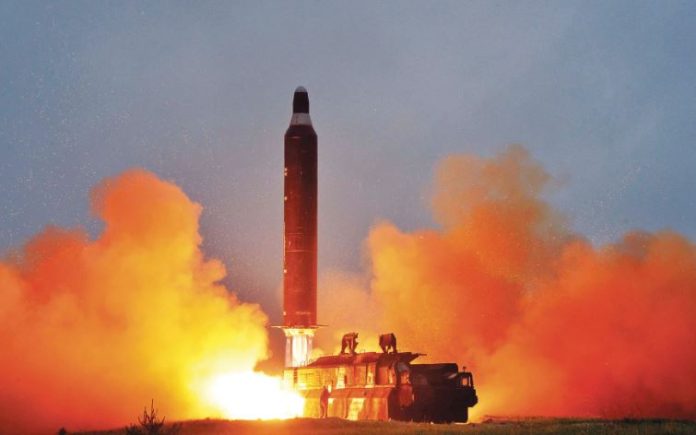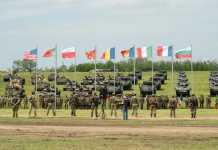In the wake of Russia’s invasion of Ukraine, old questions about nuclear deterrence have been revisited by a broad swath of academics, scholars, and pundits who have spent the past three decades acclimated to a climate of dramatically reduced nuclear risk. For those of us working in what has been a niche subfield, the attention has been both validating and, at times, surprising.
What is not often said is that nuclear deterrence is working and, as a result, both the United States and Russia face constraints in how they approach to conflict that involves the other. Nuclear deterrence has limited the escalation of the conflict in profound ways, despite brutal fighting, heavy casualties, and the supply of substantial amounts of Western weaponry to Ukraine. This is welcome news, but there is a caution: There is no guarantee that it will continue to do so, nor can there be. The management of escalation means that the United States and NATO will have to accept that it too faces limits in how to approach the conflict. It would be unwise to hand-wave away Russian nuclear threats or to dismiss as so many have the Russian threat to use nuclear weapons, based on a warped understanding of deterrence theory.
Nuclear deterrence has contained this conflict in profound ways. The existence of Russian nuclear weapons has thus far deterred the United States from directly intervening in the conflict — and this is exactly how this is all supposed to work. The threat of nuclear escalation can be deeply frustrating, especially for many in the United States that have never experienced any external limitation on how American military power can be used in support of declared foreign policy goals. Russia has nuclear weapons and, within minutes, can kill millions of people. This reality is far different from the circumstances leading up to the invasion of Iraq or the toppling of Moammar Gadhafi. These constraints have become increasingly frustrating for many advocates of greater American intervention in Ukraine.
For his part, President Joe Biden gets it, and has been clear from the outset of the conflict that he would not place U.S. ground forces in Ukraine. In rejecting a so-called “no-fly zone” over Ukraine that would require direct combat between the forces of both countries he explained,” that’s called World War III, okay? Let’s get it straight here, guys.”
At the same time, American nuclear weapons, as well as those of France and the United Kingdom, have deterred Russia from striking lethal arsenals piling up across the border in Poland for delivery into Ukraine. The Western weapons that have been so important in blunting Russia’s invasion are a perfectly legitimate military target, whether those weapons are in Poland or Ukraine. U.S. officials, however, have drawn a red line against Russian attacks on NATO states — and Russia, to date, has been deterred from striking equipment and supplies on the Polish side of the border.
Many observers have expressed frustrations with the constraints imposed by nuclear deterrence, particularly in the United States, and have sought to dismiss the role of nuclear weapons to support more aggressive policy suggestions. In one such example, former commander of U.S. European Command, Gen. (ret.) Phillip Breedlove, quipped:
We are constantly reacting to Putin. We should be the ones dictating the substance and tempo of this engagement. We are almost fully deterred, while Putin is almost fully undeterred.
Deterrence, by definition, frustrates the objectives of the combatants. And the way in which nuclear deterrence enforces these limits is through the risk of catastrophic harm. A deterrent relationship is one in which our choices are sharply constrained by existential fear. Nuclear deterrence is supposed to feel awful because it relies on a cruel assessment of human nature: People respond best of all not to love, joy, or pleasure but to the threat of unyielding pain. “There’s a logic to deterrence,” the historian Alex Wellerstein has argued, “but it is always coupled, in the end, with raw terror.”
The success, to date, of nuclear deterrence in containing escalation has been obscured by the vocal frustration of those who believed that the existence of U.S. nuclear weapons might somehow have prevented Russia’s invasion of Ukraine, despite the fact that the United States had no defense obligation (comparable to NATO’s Article 5) to come to Kyiv’s aid. This seems to reflect a profound misunderstanding of what nuclear deterrence is and how it functions. Nuclear weapons have never provided blanket protection for all states from conventional violence. The Cold War began with a Soviet-sponsored invasion of South Korea, after all. And there were numerous instances of conflict throughout the Cold War, including cases when states without nuclear weapons attacked those with bomb. Nuclear deterrence provides no guarantee, merely an incentive in favor of caution. Sometimes a leader may believe that the risk of escalation constrains an opponent more than it does her. In this case, there is the possibility of greater conventional violence beneath the nuclear threshold. Scholars know this problem as the security-insecurity paradox, although its root causes aren’t paradoxical at all. It is simply down to the confidence and risk tolerance of the combatants.
There is, therefore, no guarantee that deterrence will continue to hold. Indeed, much of the rhetoric among a certain segment of the chattering class indicates an unreasonable level of confidence that escalation to nuclear war is impossible. As Anne Applebaum wrote, “There is no indication right now that the nuclear threats so frequently mentioned by Russian propagandists, going back many years, are real.” Eliot Cohen is of the same mindset, writing that it is “Unforgivable — truly unforgivable — if the wealthy and powerful West yields to a much weaker enemy.” These analyses share an absolute certitude that Vladimir Putin would never, under any circumstances, initiate the use of nuclear weapons, or that, if he would, this decision would have nothing to do with his perception of his adversaries’ actions.
We find such certitude baffling.
It is, of course, true that both Russian and American officials manipulate risk, and that both have powerful interests in avoiding a nuclear war. But that does not mean the risk is a figment of our imaginations. Our reading of most nuclear crises from the Cold War is that, while both Washington and Moscow sought to avoid the use of nuclear weapons, there were always opportunities — by misperception, accident, or simply chance — for the nuclear powers to stumble into a nuclear war neither side wanted. Many officials in the Kennedy administration were confident that Soviet leader Nikita Khruschev would seek to avoid nuclear war under any circumstances, even if the United States were to invade Cuba. They were also certain that there were no Soviet nuclear weapons in Cuba. On the latter point, they were wrong. These kinds of historical near-misses may send a shiver down one’s spine, but that is precisely the point. Without the risk that something might go horribly wrong, nuclear deterrence would cease to function. For a world leader to feel the pinch of nuclear deterrence restraining her, she must believe that at some point things might go catastrophically wrong.
Tom Schelling argued that analysts were mistaken to talk of the brink of nuclear war as if it were the “sharp edge of a cliff where one can stand firmly, look down, and decide whether or not to plunge.” A better description, he argued, was a “curved slope.” A leader might edge his or her country out onto this slope, but “the slope and the risk of slipping are rather irregular; neither the person standing there nor the onlookers can be quite sure quite how great the risk is, or how much it increases when one takes a few steps downward.”
The United States and Russia have edged, ever so carefully, out onto this slope. The Biden administration, for example, carefully weighed the risks of providing rocket systems to Ukraine that can strike targets on the Russian side of the border before deciding, correctly in the authors’ view, that such systems should be provided. This step seems safe enough. But we should acknowledge that we do not really know and that there remains a risk of slipping. Tread carefully.
What about the next step? Will Biden hazard another footfall? Will Putin? And then there is Ukrainian President Volodymyr Zelensky. It is possible that Ukraine will use these longer-range systems to strike targets inside Russia. It is possible that Putin, frustrated in his designs on Ukraine, might choose to target Western weapons as they pile up across the border in NATO countries. There are frequent calls for Biden to attack Russian aircraft over Ukraine or sink Russian ships in the Black Sea. What would the reaction to such escalations be? As onlookers, we simply do not know where the slope becomes too steep or if Putin or Biden might put a foot wrong — and neither do they.
In the face of uncertainty, leaders can try to infer what the other might be thinking. One way to do this is to listen to what an opponent says. It is tempting to dismiss statements by our adversaries and their red lines as cynical efforts to manipulate our fear of escalation for their political gain. There is, of course, some of that in their rhetoric, and in ours. And yet they do have red lines, as do we. Knowing where the slope becomes too steep is a very interesting game of chance.
The fact that this is difficult, frustrating, and ultimately terrifying does not mean that nuclear deterrence is failing. Anticipating the Russian reaction to each increase in the lethal support given to Ukraine is not “self-deterrence.” It is simply deterrence.
On the contrary, the irreducible risk that things might go terribly wrong is necessary for nuclear deterrence to function and has held up well in this conflict. It is a feature, not a bug. And so we want to say clearly that nuclear deterrence has worked during this conflict — it has deterred direct conflict between two great powers when each has powerful reasons to escalate. We accept that it does not feel successful because successful nuclear deterrence is both frustrating and terrifying. It is frustrating because it limits our freedom of action, as it limits theirs, and terrifying because it could all fail unpredictably and catastrophically. This is not an accident. It is a mechanism by which the balance of terror functions and this basic reality cannot be wished away, or simply dismissed to support policies that intentionally dismiss what are very real threats to using nuclear weapons. Russia has the means to use these weapons and has explained how they could choose to use them. No human knows how — in that moment —a leader will respond. The goal of deterrence is to never get to that moment of choice and, at least thus far in this war, the two sides have managed to do just that.





